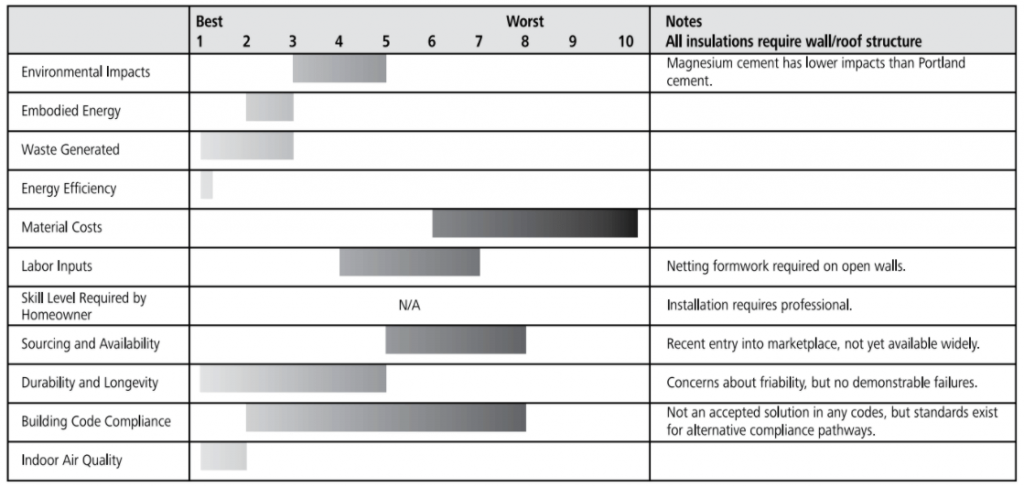cementitious foam
Insulation: MATERIALS ENCYcLOPEDIA
Applications for this system
Wall and roof insulation
Floor insulation for wood framed floors
Basic materials
Magnesium oxychloride cement
Ratings Chart for cementitious foam insulation

The ratings chart shows comparative performance in each criteria category. Click on the tabs below for detailed analysis of each criteria.
- HOW THE SYSTEM WORKS
- ENVIRONMENTAL IMPACTS
- WASTE
- EMBODIED CARBON
- ENERGY EFFICIENCY
- MATERIAL COSTS
- LABOUR INPUT
- SKILL LEVEL REQUIRED
- SOURCING & AVAILABILITY
- DURABILITY
- CODE COMPLIANCE
- INDOOR AIR QUALITY
- RESOURCES
- FUTURE DEVELOPMENT
Cementitious foam System
Cementitious foam (or silicate foam) insulation is made of magnesium oxide (extracted from seawater) plus calcium (from ceramic talc) and silicate. In its wet form the material resembles shaving cream, and it is pumped at low pressures into the area to be insulated. The material does not expand or contract after installation. It sets within an hour and dries over the course of several days. In framed walls or ceilings, one side of the frame is fully sheathed and the insulation applied in the stud cavity. In retrofit situations, the foam can be pumped into closed wall cavities.
Environmental Impact Rating
Harvesting — Moderate to High
Magnesite mining has impacts including habitat destruction and water contamination. Magnesium chloride-rich brine and seawater harvesting have minimal impacts.
Manufacturing — Moderate
Magnesium oxide cements are made at lower temperatures than portland cement, requiring less input energy to make. This type of cement also recombines with some of the carbon dioxide driven out of the ore during firing, creating a lower carbon footprint than portland cement. As with any foam material, the quantities of raw material required are quite small as the finished product is mostly air pockets.
There are no chemical foaming agents or petrochemicals involved in creating cementitious foam.
Transportation — Low to High
Sample building uses 1,023 kg of cementitious foam:
1.5 MJ per km by 15 ton truck
Impacts accrue proportional to distance traveled. Use of regional installers will keep distances low.
Installation — Negligible to Low
The material is not toxic at any stage of its creation or application. Once cured, it is very stable and does not off-gas. Trimmings can be crushed to very small quantities.
Waste: low
Compostable – Leftover cement foam can be crushed and left in the environment.
Recyclable – Metal barrels for raw ingredients.
Chart of Embodied energy & carbon
Energy Efficiency: high
R value: 3.9–4.3 per inch.
Cementitious foam can provide an effective air control layer without the use of sheet barriers. Voids in the insulation will create flaws in the air control layer, but in new construction applications it is easy to avoid gaps and voids because the material does not shrink or swell. In typical installations, a separate air and/or vapor control layer is used.
Material costs: high
Limited market penetration results in relatively high costs. Costs will likely come down as more competitors enter the market.
Labour Input: moderate
Licensed installers apply cementitious foams. The process requires a light mesh installed on vertical walls to contain the foam on the open side of the wall. Install times are comparable to other spray foam systems.
Skill level required for homeowners: N/a
A licensed installer is required.
Sourcing & availability: moderate to Difficult
Cementitious foam insulation is a relative newcomer to the insulation market. The number of installers is growing, but distribution is uneven across the continent. Check with manufacturers for their distributors and installers closest to you.
Durability: moderate to High
Cementitious foam is a very stable material and is not susceptible to rot, mold, decay or pest infestation. The hardened foam is very friable, which means it crumbles easily. Once installed and sealed, little should cause this to happen, but some concern has been expressed about potential damage caused by heavy vibration.
The material is not transferrable or reusable.
Code compliance
Cementitious foams are not recognized in most building codes, but proprietary brands of the material have undergone all the testing required for insulation materials and are expected to be accepted in the near future. It should be straightforward to show compliance with codes.
Indoor air quality: high
Cementitious foams have many characteristics that make them a good choice for high indoor air quality. The material is vapor-permeable, reducing the chances of trapped moisture causing mold. The material itself is resistant to mold, non-allergenic and does not off-gas. No dust or toxic gas is generated during the installation or in situ.
Resources for further research
n/a
Future development
Limited distribution of cementitious foams causes prices to be higher than other insulations, but as the material gains more market share based on its strengths costs should become more competitive. The benefits of this type of insulation — especially for the chemically sensitive — are likely to drive demand.
Tips for successful cementitious foam insulation
Licensed installers apply cementitious foams and will provide instructions for proper preparations prior to installation.




